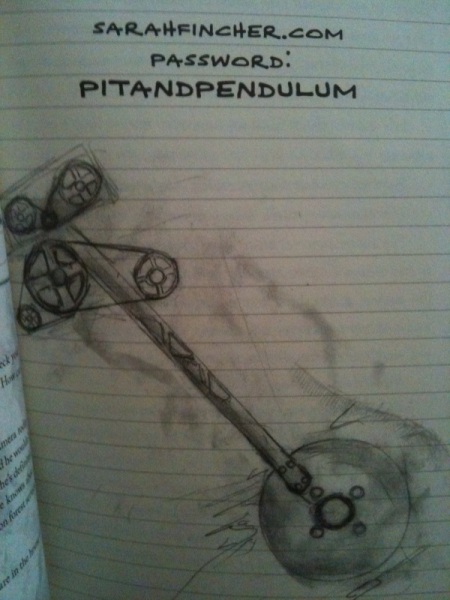Analysis of ‘pitandpendulum’
The third password that we receive in Skeleton Creek happens to be another reference to a written piece by Edgar Allen Poe. I’m beginning to see a trend. But why try to fix something that isn’t broken? Using these references to Poe’s pieces has given incredible insight into the characters and nuances within the story that are otherwise lost. Perhaps the same effect can be achieved through other references, but for now it seems as though the sad, somber, and significantly psychotic parables of E.A. Poe add a great deal to the Skeleton Creek story.
As with the last few analyses of Poe’s passwords, it is key to spend time studying the story in order to understand why it is embedded within Skeleton Creek. The more we know, the more we can learn. “The Pit and the Pendulum” is the story of a prisoner sentenced to death during the Spanish Inquisition. After receiving his death penalty, the narrator loses consciousness, but soon awakens in a shapeless, darkened room. Under the impression that most prisoners are given public hangings, the narrator is confused as to why his punishment would be any different. After considering the possibilities and finding his bearings, he realizes that he’s in a dungeon at Toledo, one of the notorious Inquisition prisons. Between his spells of unconsciousness, through exploration our narrator discovers a pit of indeterminable depth in the center of the cell.
The narrator wakes once more to find himself strapped to a board, looking up at a scythe that is moving back and forth across his body in a pendulous motion. He realizes that the blade is only getting closer and in an act of desperation, lures the dungeon-dwelling rats to chew through his binds. The situation only grows more ominous as the walls heat up and begin to enclose. However, at the last possible moment the walls cease their movement and the narrator is grabbed by a mysterious arm, saving his life from the certain-death that awaited him in the pit. The French army had taken control of the prison at Toledo, saving this man’s life at the last possible instant.
Exactly how historically accurate this story is, remains up for debate. Just the same, the story lends itself to some pretty powerful commentary within the context of Skeleton Creek. The first question that comes to mind is, why now? What makes the reference relevant within this part of the story? I believe the answer to that question is hidden aurally. A great deal of the descriptions given within the story relies on auditory (aural) stimulus. The same thing can be said for the Sarah’s ‘pitandpendulum’ video. As she talks to Ryan, Sarah is analyzing the audio from the dredge. She has him focus on the sounds of Joe Bush’s leg dragging across the wooden floor and the noises she heard while standing outside the dredge. She questions her own ears saying, “maybe I’m hearing something that isn’t even there.” The most important thing to take away from all this being, all information can be twisted and distorted. Even trusting something as basic as your own senses; touch, sound, sight, can you have you relying on false facts. Never accept anything at face value because even in the best circumstances your own instincts can be the culprit playing tricks on you.
This piece also seems to be achieving relevant commentary on Ryan’s accident within the dredge. The similarities between the narrator and Ryan are unmistakable. The narrator in Poe’s story is tortured through fear knowing that the entire time he’s being held captive, his captors are watching. Ryan’s situation is remarkably similar, as he feels like a captive in his own home unable to see Sarah, his parents constantly watching him. The possibility exists that instead of Ryan’s parents being the equivalent of the captors, it is instead the ghost of Joe Bush that is watching Ryan, torturing him and holding him captive with fright.
Continuing down the same path of questioning, whose arm is it that extends to the narrator of Poe’s story? We can imagine the arm reaching out at the last second, a nameless and faceless savior. Is Sarah also reaching out to Ryan, trying to help him from falling deeper into his own cavernous pit of paranoia and fear? Or perhaps in Ryan’s case, the arm that extends is not there to pull him back up to safety, but instead belongs to the ghost who has pushed him over the railing.
This password provides less in the way of foreshadow than it does in passive commentary on what is happening with Ryan and Sarah and this moment. It is clear that looking into Poe’s “The Pit and the Pendulum” allows us to look further into Skeleton Creek at the same time. The similarities are there and it doesn’t take a keen eye to spot them, just an inquisitive nature.
Questions still linger as to what the relationship between Sarah and Ryan is like from their respective perspectives. Is Sarah compassionate at all to Ryan’s fears and anxieties, or does she enjoy the ability to take advantage of those qualities and manipulate him as her own personal marionette? Does Ryan believe in any of this or is he embellishing the story to add realism to his perceived sense of fear? Could it be possible that what we are reading is in fact not Ryan’s journal at all, but a fictional story that he’s fabricated? He is a writer after all, living as a teenager in a small town. What do we have that proves it isn’t all based on something that a bored teenager thought up and put on paper? These are exactly the kinds of questions that these intricate literary references should cause you to ask.


April 5, 2010 at 8:28 pm
what does the birdie have to do with any of the passwords